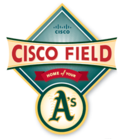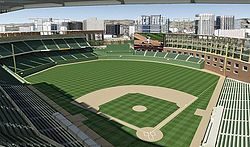- Cisco Field
-
Cisco Field 
Location San Jose, California Coordinates 37°19′45″N 121°54′4″W / 37.32917°N 121.90111°WCoordinates: 37°19′45″N 121°54′4″W / 37.32917°N 121.90111°W Opened 2015 (projected)[1] Owner Oakland (San Jose) Athletics Operator Oakland (San Jose) Athletics Surface Grass Construction cost $400 million (USD) Architect 360 Architecture
GenslerCapacity 32,000+ (baseball)[2] Field dimensions Left Field - 302 feet (92 m)
Left-Center - 375 feet (114 m)
Center Field - 405 feet (123 m)
Right-Center - 345 feet (105 m)
Right Field - 310 feet (94 m)Tenants Oakland (San Jose) Athletics (2015–) Cisco Field is a proposed ballpark in San Jose, California. It is the proposed new home of the Oakland Athletics; however, the opening date has yet to be determined. It will be replacing their current home at O.co Coliseum, where the team has resided since their move to California in 1968. This stadium will mark the first time that the A's franchise has received a brand new stadium in which to play since the completion of Shibe Park in 1909.
Contents
Cisco Field in San Jose
Cisco Field is proposed to be constructed in downtown San Jose immediately adjacent to the HP Pavilion and the Diridon Station at the corner of Montgomery Street and Park Avenue.[3] The ballpark, if built, would open in time for the 2015 season. For the A's to move to San Jose, either the San Francisco Giants would have to rescind their territorial rights on the area, or at least 23 of the 30 MLB owners would have to vote in the A's favor and force San Francisco to give up their territorial claim to Santa Clara County. Lew Wolff has stated, "My goal and desire for the organization is to determine a way to keep the team in Northern California."[4] The Redevelopment Agency of the City of San Jose[5] has been acquiring the properties needed at the Diridon South site.[6] The available land, only 12-14 acres, would give rise to a very intimate stadium. As a result of its small size, it is speculated to be very hitter-friendly.[7]
Previous attempts
Cisco Field in Fremont
In April 2006, A's owner Lewis Wolff first took a modified version of his Ballpark Village proposal to the suburban San Francisco Bay Area city of Fremont where a large 143-acre (0.6 km2) parcel of land is available just north of Mission Boulevard and south of Auto Mall Parkway off Interstate 880 and across from Pacific Commons. The land is currently owned by ProLogis, a real estate firm, and leased to Cisco Systems.[8] The land had been purchased in the late 1990s in anticipation of company growth by Cisco that never occurred due to the dot com bust. More land was purchased by Lewis Wolff's development group to bring the parcel up to approximately 240 acres (1.0 km2) at the ballpark village site.
A formal press conference to announce the existence of Cisco Field was held on November 14, 2006. Bud Selig, commissioner of Major League Baseball and John Chambers, the CEO of Cisco Systems along with Wolff, were in attendance.
The plan called for the 240 acres (1.0 km2) to be developed into a combination of commercial, retail, and residential spaces in addition to the construction of the stadium. The planned development is similar to the Santana Row development in nearby San Jose, California with the addition of the baseball park. The planned name for the park is Cisco Field, as first announced by the Fremont city council after meeting with Wolff on November 8, 2006. The stadium will be privately financed, primarily from sales of the residential and commercial properties in the surrounding "ballpark village" to offset the cost of the stadium. The site plan proposes 540,000 square feet (50,000 m2) of commercial space adjacent to the ballpark, and would include a hotel, restaurant, movie theater and several parking garages of varying size. Its plans also call for 3,150 homes. More than 600 of those residences — including 50 each behind the left and right-field bleachers — would be sprinkled into retail space north and east of Cisco Field. In addition, 1,900 townhomes and 700 homes would be built on 115 acres (0.5 km2) south and west of the ballpark. The housing will be built in phases, and designs show that a 41-acre (170,000 m2) team-owned parcel would provide nearly 3,190 parking spaces (West Cushing) until the townhomes are built there.
The earliest the stadium would have opened was for the 2014 season. On November 10, 2008, Lew Wolff reiterated that the construction of Cisco Field was still very much a priority, and that negotiations were proceeding as planned, beginning with the first drafts of the environmental impact reports.[9] The reports came back positive, but the team encountered resistance from the community and the Fremont City Council (which had not approved the deal). "We're literally going door to door talking to people," Wolff related. "They think we're going to bring gangs into the community." MLB Commissioner Bud Selig sent Wolff a letter indicating that a move to other communities, such as Santa Clara County (which had been considered the territory of the San Francisco Giants), would be possible. Wolff indicated that a decision on whether to relocate would come by June.[10]
On February 24, 2009, Wolff officially ended the search for a ballpark in southern Alameda County.[11]
66th Avenue in Oakland
Oakland Athletics owner Lew Wolff presented his vision for the team's venue to the Oakland-Alameda County Coliseum Authority on August 12, 2005. The ballpark he proposed would have held roughly 35,000 fans making it the smallest park in Major League Baseball. The proposed location was to have been on 66th Avenue just north of the A's current home, the Oakland Coliseum. The stadium would have been built on what is currently zoned industrial land and would have included a Ballpark Village which would have had apartments and condominiums. The plan also called for a hotel to be built into the park along with shops. The new ballpark would also have been close to both Interstate 880 and the BART system which was the primary draw of the location. However, a new BART station or a permanent link to the existing Coliseum BART station was going to have to be built to make the plan viable according to the Athletics.
In December 2005, the 66th Avenue location was abandoned when Wolff revealed that the more than 70 current owners of the land desired for the new stadium were unwilling to sell. Wolff asked the city of Oakland to acquire the land for the stadium by either providing public land or purchasing private land while he and other private developers would cover the cost of construction. Oakland was unresponsive to these requests.
Other options
Other options being pursued by outside sources ranged from other locations in the city of Oakland or suburban locations inside Alameda County to moving the team out of the Bay Area altogether. The most promising of these had been a site in uptown Oakland. In a 2001 study, Populous (formerly HOK Sport) had suggested this as the prime site for a ballpark; however, plans to build a park there were canceled by then-Oakland Mayor Jerry Brown. Brown (now the Governor of California) opted to sell the site to a condominium builder to whom he allegedly had ties.[12] The City of Oakland also considered a site near the Oakland Estuary for a stadium; however, the A's showed no interest in the site due to lack of public transit access. Another possible location that was explored was land directly adjacent to the Coliseum, to the southeast, in what is currently overflow parking, which would have meant the two stadiums would share a parking lot. However, much of that land had already been sold to a condominium developer.
On November 16, 2010, the City of Oakland selected a waterfront site in the Jack London Square area for a new A’s ballpark. The site, called Victory Court, is near the Lake Merritt Channel, along the Oakland Estuary. The city is conducting an environmental impact report for the Victory Court site and has informed Major League Baseball of its decision. The city began accepting public comment on the ballpark EIR at the December 1 Planning Commission meeting held at Oakland City Hall.
References
- ^ http://newballpark.org/2010/08/30/diridon-walking-tour
- ^ http://msn.foxsports.com/mlb/story/Oakland-Athletics-San-Jose-move-decision-accelerated-by-MLB-111911
- ^ http://www.nbcbayarea.com/enjoy-this/San-Joses-Cisco-Field-101433279.html
- ^ http://www.ktvu.com/news/18785592/detail.html
- ^ http://www.sjredevelopment.org/ballpark.htm
- ^ http://www.mercurynews.com/scott-herhold/ci_16807564
- ^ http://www.hardballtimes.com/main/article/home-run-park-factor-a-new-approach/
- ^ Oakland A's sign Fremont land deal San Francisco Chronicle
- ^ http://oakland.athletics.mlb.com/news/article.jsp?ymd=20081110&content_id=3674036&vkey=news_oak&fext=.jsp&c_id=oak Wolff: New ballpark 'on track' oaklandathletics.com
- ^ http://oakland.athletics.mlb.com/news/article.jsp?ymd=20090114&content_id=3744414&vkey=news_oak&fext=.jsp&c_id=oak Door opens for A's in Santa Clara oaklandathletics.com
- ^ http://www.bizjournals.com/sacramento/stories/2009/02/23/daily28.html
- ^ http://www.sports-venue.info/MLB/OAK_Cisco_Field.html
External links
- MLB.com article featuring a photo gallery
- Cisco field renderings at Baseball San Jose
- First confirmation of name
- ESPN article November 2006
- Status as of January 2006
- New A's Ballpark Blog by Marine Layer
- SJ Mercury News Article
- John Chambers Mercury SJ News Opinion Article
- Video demonstration of stadium technology from Cisco
- Pacific Commons Retail Properties LLC
- Cisco Field news and history
Categories:- Proposed stadiums in the United States
- Major League Baseball venues
- Oakland Athletics stadiums
- Sports venues in the San Francisco Bay Area
Wikimedia Foundation. 2010.

